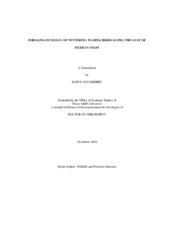| dc.description.abstract | I studied flock composition, distribution and foraging ecology of wintering wading birds
along the Gulf of Mexico coast. I focused on geographic variability in wintering wading bird
assemblages, the processes that structured these assemblages and habitat use by wading birds. I
found considerable variation among three sites, Aransas National Wildlife Refuge (ANWR),
Texas; Marsh Island Wildlife Refuge (MIWR), Louisiana; and Chassahowitzka National Wildlife
Refuge (CNWR), Florida. Species comprising wintering wading bird assemblages varied
regionally. ANWR had the most species-rich assemblage, with eight species. MIWR had only
six wading bird species. And CNWR had only three different species.
Processes that structured wintering wading bird assemblages also varied regionally. In
ANWR, Texas, the Random Fraction niche apportionment model (RF model) best explained the
empirical abundance data for ANWR. For abundance data from MIWR a good fit was obtained
with the MacArthur Fraction (MF) model and the Power Fraction (PF) models. None of the
models fully explained the CNWR abundance data.
I also examined patterns of habitat partitioning among wintering wading birds at three
different scales at two sites, Matagorda Island National Wildlife Refuge (MINWR) and Laguna
Atascosa National Wildlife Refuge (LANWR). At the macrohabitat level, wintering wading birds
showed interspecific differences in macrohabitat use of both open water habitats and vegetated
flats. At the mesohabitat level all species at MINWR used the category nearest the edge most often, alternatively, at LANWR wading birds were most often in the mesohabitat category of 8.1-
12 m. from the edge. In both locations wading birds partitioned habitat based on water depth.
Finally, I found that Great Egrets and Snowy Egrets participated more often in flock
foraging and derived more benefits from feeding in flocks than other species. Great Egrets
feeding in flocks had a higher mean strike rate than those foraging alone, whereas Snowy Egrets
had a higher success rate foraging in flocks than those foraging alone. In the case of the darkercolored
species (e.g., Great Blue Herons, etc.) they either showed no difference in behaviors
between birds foraging in flocks versus those foraging alone or they actually did worse when they
foraged in flocks. | en |


